Formula One: 1987 Detroit GP
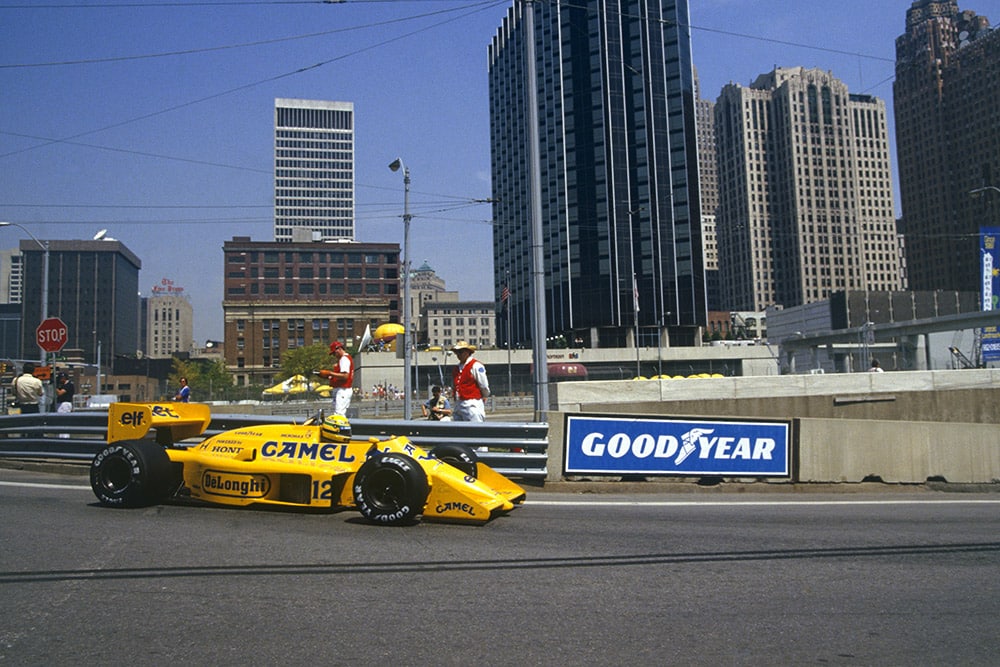
Ayrton Senna heading for a win in his Lotus 99T Honda.
© Motorsport Images
Streets ahead
The Detroit Grand Prix hammered home the same message we have been hearing since the start of the 1987 season — namely that there are now three distinct categories within Formula One: non-turbos, turbos and Hondas. It was not simply the fact that Nigel Mansell took his fifth pole position in six races which was so impressive, but the real index of the collective mastery of Williams, Lotus and Honda was that the gap between Nelson Piquet’s Williiams FW11B (third on the grid behind Mansell and Ayrton Senna’s Lotus 99T, and fourth man Thierry Boutsen’s Benetton-Ford B187 was a staggering 1.1sec!
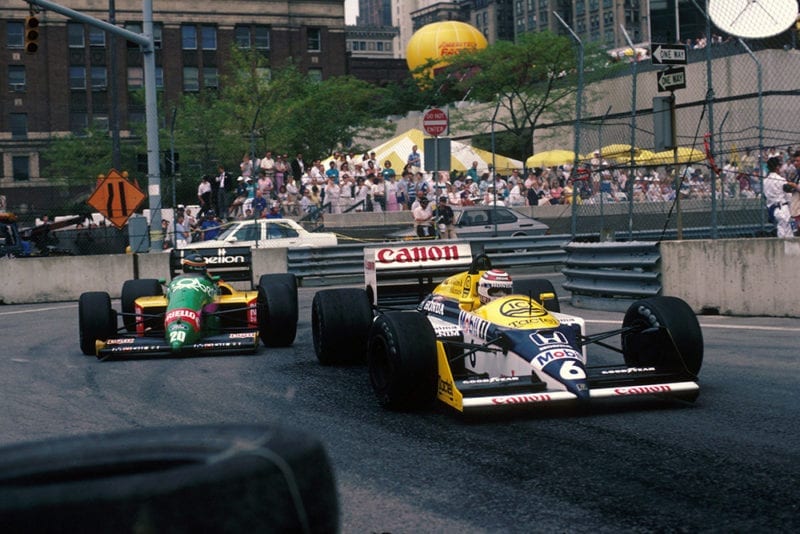
Nelson Piquet in his Williams FW11B.
© Motorsport Images
Honda had produced yet another update of its successful V6 engine — officially and curiously dubbed the ‘GE two-step’ — incorporating an improved combustion chamber design to offer more power, even further improved economy and better flexibility.
This is all part of the on-going development programme which may well see Honda running through the 1988 season with its turbochurged engine running to the 2.5-bar/150-litre rule which will be applied from January 1. For the time being, of course, the Japanese engine manufacturer has simply left all its rivals wondering how they can get on terms with, never mind beat, Williams and Lotus.
Of course, it is not simply Honda which is responsible for this front-running status. Williams has done a magnificent job refining last year’s car into its highly competitive FWI1B specification, while the Lotus 99T, although by common consensus not as aerodynamically excellent as the Williams, nonetheless enjoys the advantage of the computer-controlled active suspension which has been painstakingly developed over the past seven years.
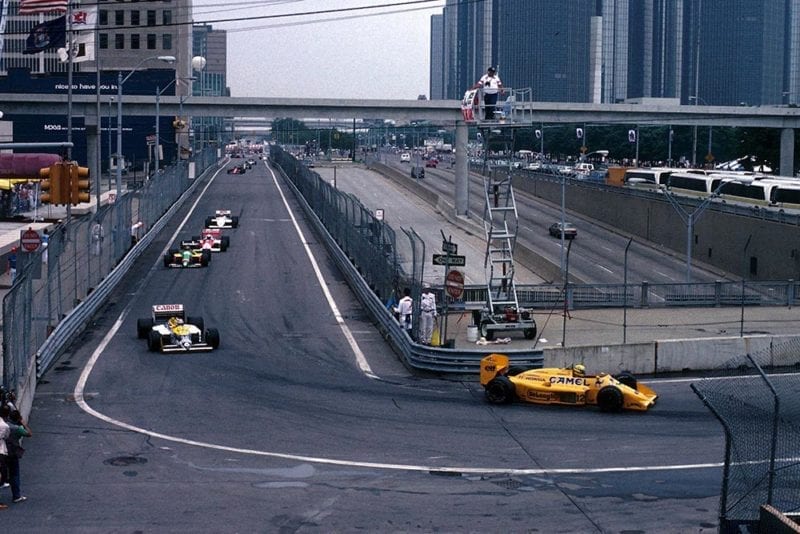
Ayrton Senna (Lotus 99t), leads 2nd placed Nelson Piquet (Williams FW11B).
© Motorsport Images
And of course, one can hardly overlook the drivers. Between them, Mansell, Senna and Piquet have won 14 Grands Prix since the start of the 1986 season. Mansell was in a class of his own on Detroit’s partly-resurfaced street circuit, laid out round the spectacular tinted glass and concrete Renaissance Centre in ‘downtown Motown’, America’s motor city. Many of the drivers find this unruly scramble through the streets a most unpopular interlude, Alain Prost in particular condemning it openly and publicly to anybody who would listen. “There are plenty of better tracks in the USA and it just seems a shame that we have to come to this one on our sole visit to America,” said the reigning World Champion.
That view was echoed by many of his rivals, but Detroit remains a good place for Formula One to put its wares on show right under the noses of top motor industry bosses. Bernie Ecclestone made it quite plain that, in his view, the United States’ motor industry has dragged its heels disgracefully when it comes to giving the race a worthwhile amount of support; however, as we went to press, negotiations were well in hand for a fresh contract which would guarantee the Detroit Grand Prix’s presence on the calendar through to 1991.
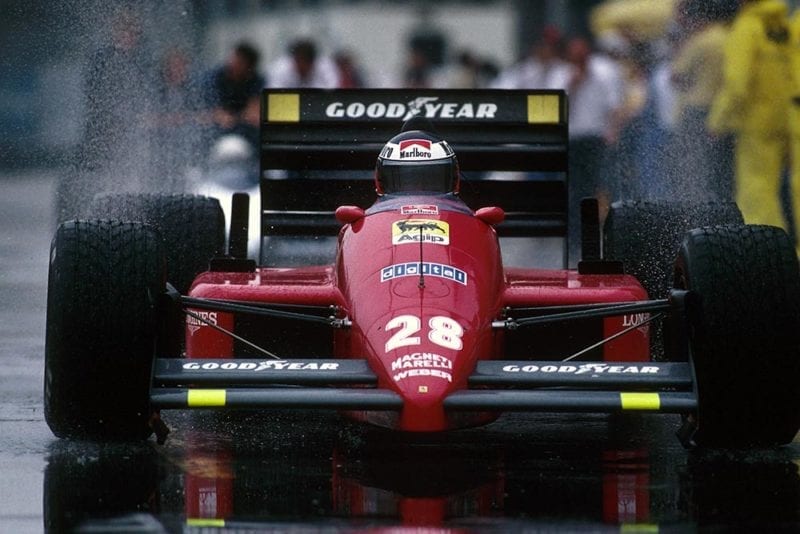
Gerhard Berger in his Ferrari F187.
© Motorsport Images
Mansell was in his usual spectacular form, having ruthlessly shoved his Monaco disappointment out of his mind. Despite a spin in first qualifying and a broken fifth gear mid-way through the second, he took pole position with ease. Senna jousted briefly with him on Saturday, but realised after his first run that there was simply no way of getting on terms with the Williams, so he spent the rest of the session trying to work out a good race set-up.
Piquet, meanwhile, did his level best to conceal his dislike of claustrophobic street circuits, grappled with third-gear selection problems and also wiped his FW11B’s nose section off on a wall, after a quick spin on Saturday. But he was still a comfortable third on the grid.
Boutsen’s elevation to the status of fastest non-Honda runner was the by:product of some serious engine development on the 120deg. Ford V6, which had hitherto been hampered by very poor throttle response. However, major changes to the electronic management system and the turbos had eliminated this problem, allowing a delighted Boutsen to unlock some of the B187’s potential on this tight circuit, happily in front of some Ford ‘high rollers’ including Edsel Ford II, grandson of the company’s founder and a passionate motor racing enthusiast.
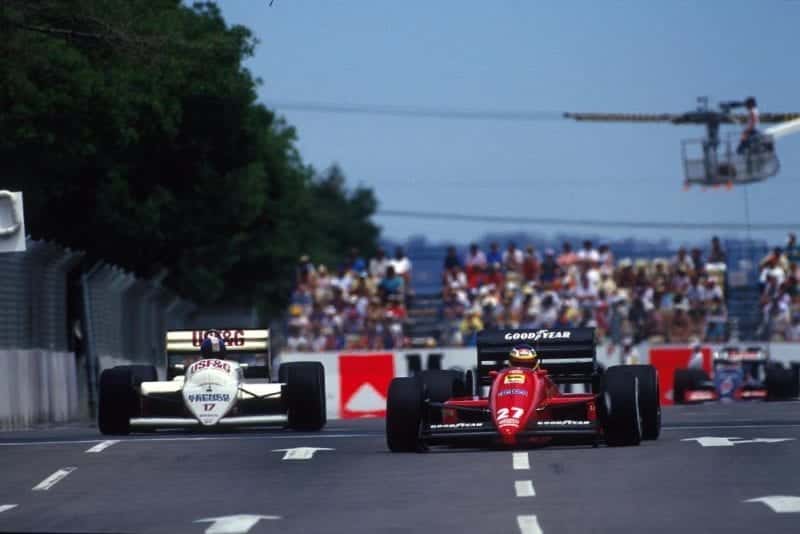
Michele Alboreto did not finish in his Ferrari F187.
© Motorsport Images
Behind Boutsen came Alain Prost’s McLaren, the World Champion running with a substantial fuel load in second qualifying in a (successful) attempt to produce more grip, while a tremendous effort from the on-form Eddie Cheever put the American’s Arrows A10 on the outside of row three.
In the Ferrari camp there was plenty of experimentation going on with new differentials and weight saving carbon-fibre clutches, the latter also being used by Lotus and Williams throughout the weekend. Michele Alboreto qualified seventh despite brushing a wall and bending a steering arm on Saturday, the Italian using his spare car after deciding he preferred it during the morning untimed session. Berger was a disappointing 12th after a rear hub problem sent him spinning backwards into one of the walls on Saturday afternoon, losing a lot of time while the rear wing and suspension were repaired.
Completing the top ten behind Alboreto were Fabi in the second Benetton, Riccardo Patrese Brabham BT56 and Derek Warwick, whose Arrows had been sixth on Friday but slipped back after an untimely engine failure mid-way through the second session.
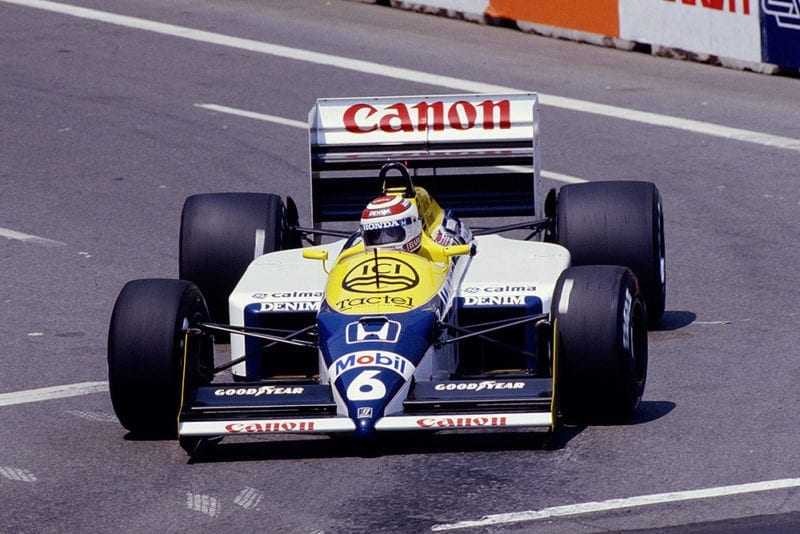
Nelson Piquet at the wheel of his Williams FW11B Honda.
© Motorsport Images
Further back promising performances were put in by the two naturally-aspirated Tyrrell DG/016s. Jonathan Palmer and Philippe Streiff lined up 13th and 14th, exploiting their chassis’ agility to the full on this tight circuit, Jonathan having the added satisfaction of out-qualifying fellow Englishman Martin Brundle who had taken his place in the Zakspecd team at the start of the year.
In fact, Brundle had a really miserable two days of qualifying, his new 871 briefly catching fire with a fuel tank leak in the engine bay on Friday, then sliding into the wall thanks to a brake balance malfunction on Saturday. That shunt damaged one of the one of the suspension pick-up points too badly for the car to be repaired at the circuit, so Martin had to take the spare 861 for the race.
Detroit’s weather had been changeable for much of the weekend and when Sunday dawned dank, wet and overcast, prospects for the race looked depressing. Thankfully the conditions improved considerably although it was rather overcast and humid when the cars lined up to take the start.
Mansell catapulted into an irrunediate lead, Pulling comfortably away in the early stages with Senna looking equally in control of second place. Piquet was third for the first few laps, but when he was easily outbraked by Cheever at the end of the back straight it was obvious he was in trouble. Sure enough, the Brazilian came in to change tyres at the end of lap three, having picked up a puncture in one of his front Goodyears.
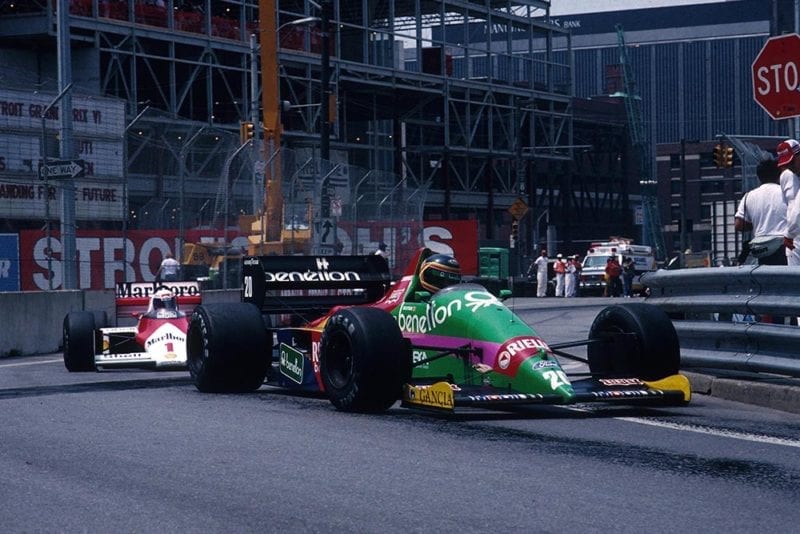
Thierry Boutsen driving his Benetton B187.
© Motorsport Images
This allowed Cheever a few glorious laps in third place, but Fabi came swooping up onto his tail in the Benetton, running into the Arrows right rear wheel and puncturing the tyre when Cheever slammed the door on the Italian going into the 90° right-hander behind the paddock.
Fabi’s car lost its nose section in the collision, and although both cars made it back to their pits, only Cheever was able ro resume after a fresh set of tyres had been fitted. The nose mounting points on Fabi’s Benetton had been damaged and, there being no way of fitting a replacement, the car had to be retired.
After the first few laps Senna began to feel his brake pedal going spongy and, mindful that a similar problem had sent him into the wall at Detroit in 1985, he eased back until he felt more confident again. That strategy was to help him enormously later in the race. Meanwhile, Mansell steadied his advantage at around 12 sec, never looking even remotely flustered or worried, reeling off the laps with total confidence and control.
Unhappily for the Englishman, he was about to experience a re-run of the Monaco Grand Prix, although this time it was a human malfunction rather than a mechanical one which put paid to his chances.
At the end of lap 34, he came into the pits to change tyres, a routine stop which was planned in advance. It proved an excruciatingly slow change, a sticking nut on the left rear wheel drawing it out to a frustrating 17.4 sec. By the time he returned to the fray, Senna had gone through into the lead, but Mansell got his head down and pressed on in his usual determined fashion.
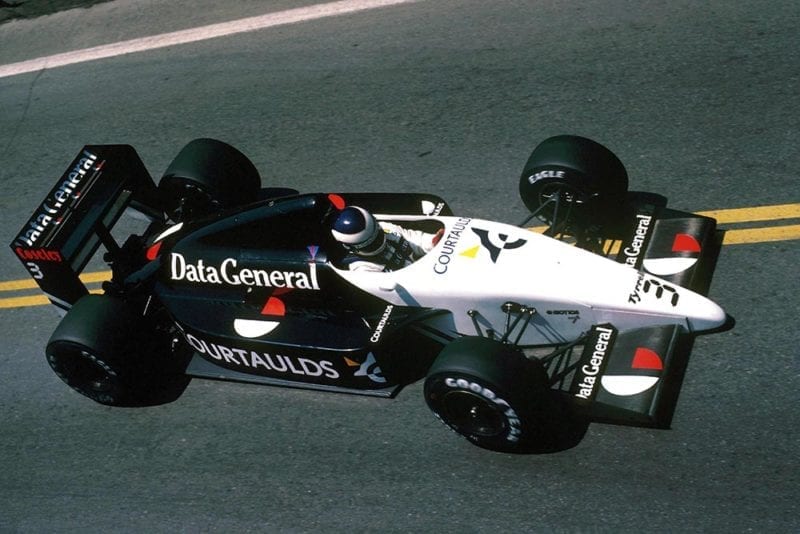
Jonathan Palmer finished 11th in his Tyrrell DG016.
At the speed he was going, and with Senna still to make his tyre stop, he would easily catch and repass the Lotus before the end of the race. Or so most of us thought. That assumption, of course, was based on what turned out to be two totally false premises, the first being that Mansell would have a trouble-free run for the rest of the race (which he did not) and the second that Senna would stop for tyres (which did not happen either).
Ten laps or so after Mansell’s stop, the Williams pit began to be concerned that their driver was in trouble. Initially there was a suspicion that he might have run too hard and taken the edge of his tyres. Sadly, Nigel was suffering from cramp in his right leg, something that must be a truly frightening experience in the claustrophobic confines of a Formula One cockpit. Without the prospect of moving his troubled limb, the problem became worse and worse, to the bitter disappointment of the English driver. He faded to fifth place at the chequered flag, handing victory on a plate to arch-rival Senna who also had the satisfaction of lapping the Williams shortly before the finish.
As it turned out, Senna never made a stop for new tyres. Easing up as he sensed that brake problem early in the race meant that he had a littls bit more rubber left on the original Goodyears towards the end of the race. Also, while the computer-controlled ‘active’ suspension system may have contributed a small advantage in that area, the biggest bonus came from the fact that the Lotus’ silky-smooth ride took the bare minimum of physical toll on the Brazilian, allowing him to perform at his peak for most of the race. Certainly, he looked as fresh as a daisy after climbing onto the winner’s rostrum.
From 20th place after that early pit stop, Piquet came charging through to a fine second place without another change of tyres for the rest of the race, while Prost took a reasonable third, satisfied to come home with a top three finish in a race which has always proved so difficult for the McLaren-TAGs in the past. Prost made a routine stop for tyres, later commenting that the team had been over-cautious in this respect and that he believed he could have gone through non-stop without too much trouble.
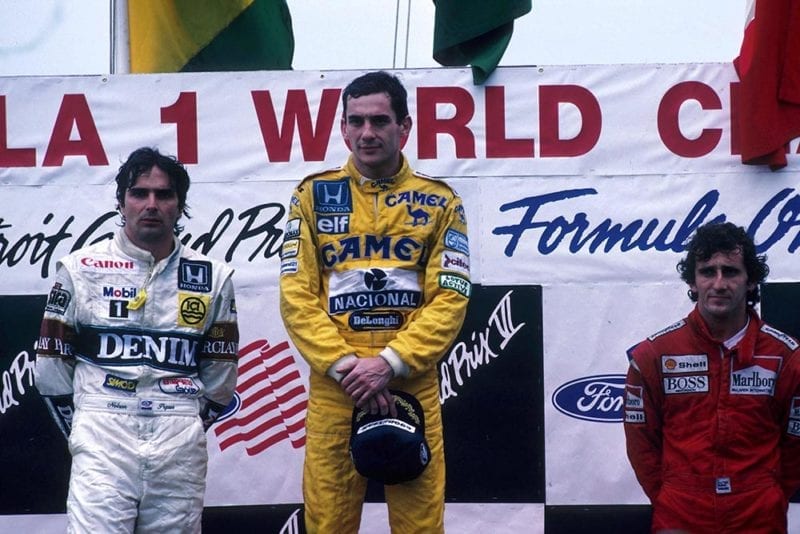
Ayrton Senna, 1st place (C), with Nelson Piquet, 2nd (L) and Alain Prost 3rd place (R) on the podium.
© Motorsport Images
Fourth place fell to the sole surviving Ferrari of Gerhard Berger (Michele Alboreto having succumbed to gearbox trouble), while Cheever completed the top six behind Mansell and ahead of Stefan Johansson, whose McLaren was delayed in the pits with a long stop to sort out electrical trouble. Danner’s Zakspeed was eighth in front of Patrese’s Brabham, the Italian delayed with a couple of stops to re-fasten a seat harness buckle which kept coming undone. Rene Arnoux’s slow Ligier completed the top ten.
In the non-turbo division, Palmer seemed to have lost all chance after an early pit stop to repair suspension damage sustained when he clipped Patrese’s spinning Brabham. But Alliot was taken off by Arnoux, and Streiffs Tyrrell lost a rear wheel coming onto the pit straight, which allowed Palmer to inherit eleventh place overall, winning the non-turbo class. Of course, the other two classes had already fallen to Ayrton Senna and Alain Prost respectively . . . AH
